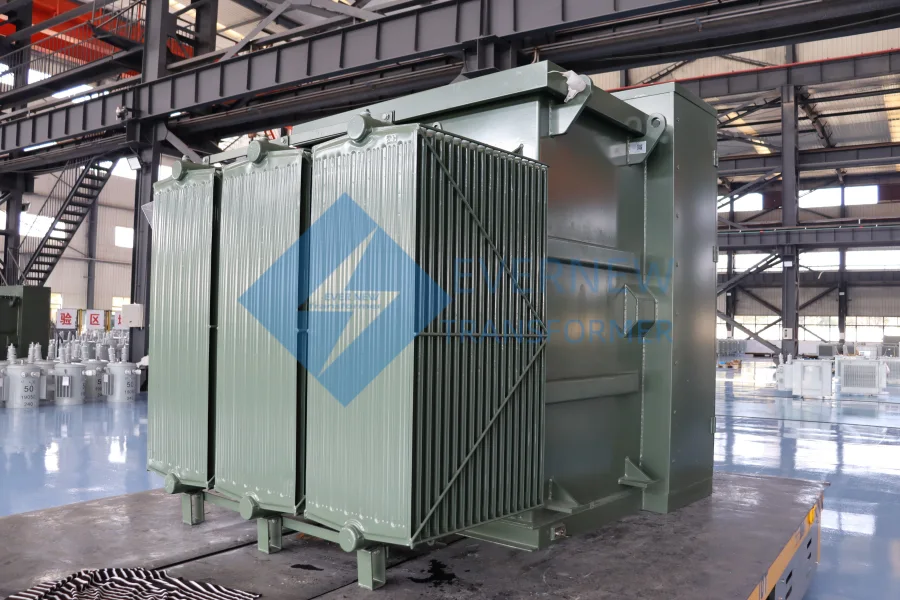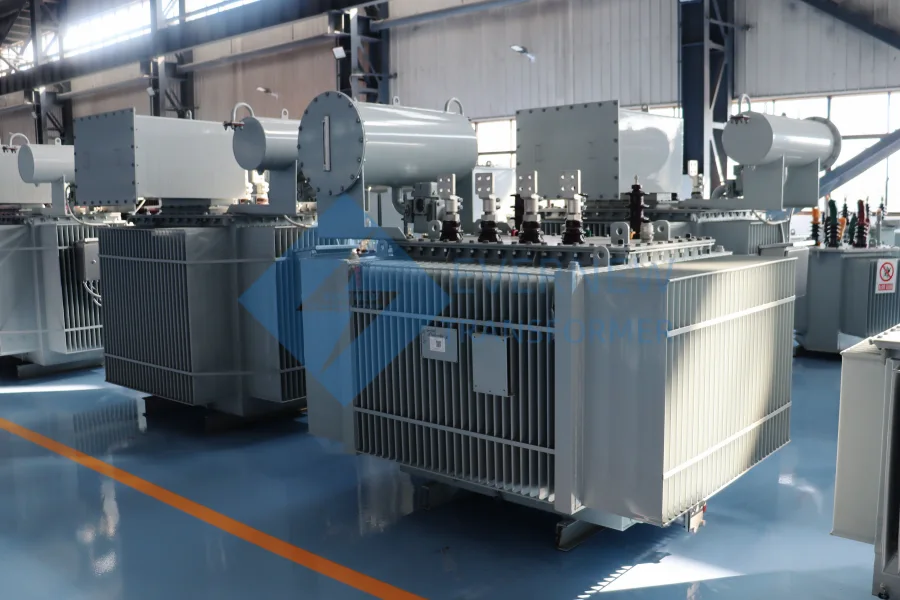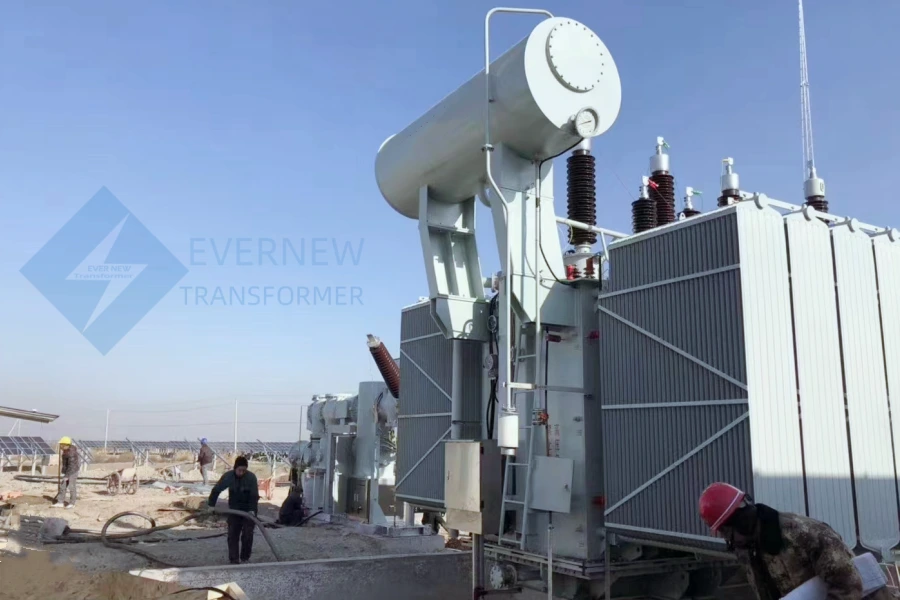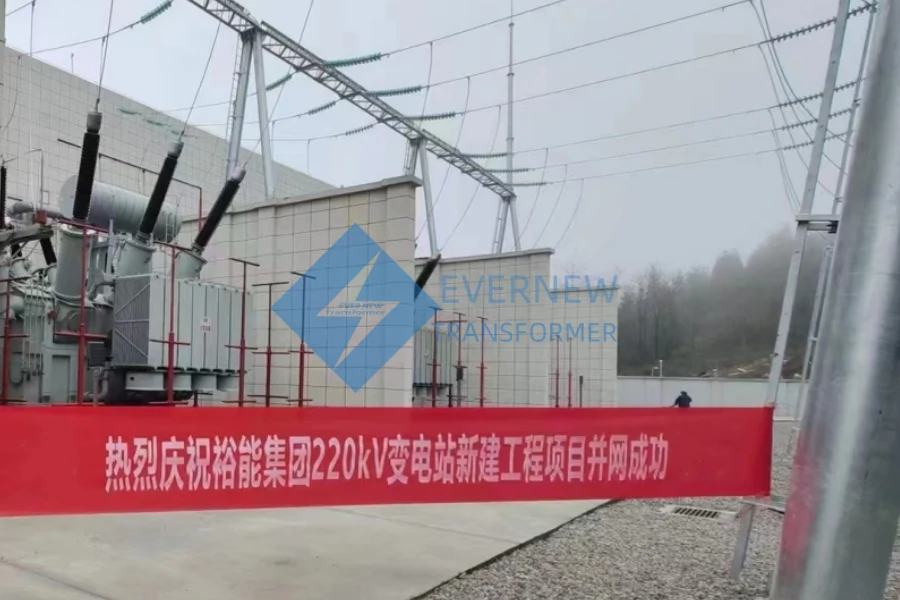With the rapid development of the global economy and technology, electricity has become an indispensable fundamental energy source in modern society. Nearly all the devices and facilities around us rely on electricity. However, electricity is not directly usable; it needs to be transformed by a transformer to ensure it is delivered at the appropriate voltage levels for residential and industrial use. The electrical substation transformer is a key component in this process, responsible for converting high-voltage electricity into voltages suitable for various needs. Today, we will delve into the role and working principles of the electrical substation transformer.
Evernew Transformer, with over 30 years of experience as a transformer manufacturer, is committed to providing high-quality transformer products and solutions for the global power industry. With strong research and development capabilities and excellent manufacturing technology, Evernew Transformer’s products are widely used in power systems worldwide, earning the trust and recognition of customers. Moving forward, Evernew Transformer will continue to uphold its principles of innovation, quality, and customer service, providing reliable and efficient transformer products and support to customers around the globe.
In the operation of power systems, the electrical substation transformer is not only a key device for power conversion but also plays an essential role in ensuring the stable and reliable transmission of electricity. This article will introduce the common types of electrical substation transformers and their crucial role in power processing, helping readers better understand the working principles and applications of electrical substation transformers.
Read More:Distribution Transformer
Electrical Substation Transformers: What Are They and Why Are They Important?
What is an Electrical Substation Transformer?
An electrical substation transformer is one of the most critical components in a power system. Its primary function is to step up or step down electrical voltage to a level suitable for efficient transmission and distribution, making it possible for electricity to be delivered from power generation plants to end users. The electrical substation transformers manufactured by Evernew Transformer are built using advanced technologies and high-quality materials, ensuring precise voltage conversion, enhanced efficiency, and operational stability.
Why Are Electrical Substation Transformers So Important?
Without high-efficiency and stable electrical substation transformers, the transmission of power from generation plants to consumers would be inefficient and unreliable. Electrical energy would face significant losses, and the risk of system failures would increase. Evernew Transformer’s electrical substation transformers ensure the smooth and efficient transfer of electricity, reducing energy losses and ensuring a stable power supply to facilities worldwide. These transformers are essential for maintaining grid stability and meeting the growing energy demands in diverse sectors, from residential areas to industrial applications.
In addition, electrical substation transformers are categorized into two main types based on the material of the winding conductor: copper-wound and aluminum-wound transformers. Most factory substations use double-winding transformers, which provide flexibility and durability for high-demand applications. This dual winding design allows for improved performance and efficiency, making them a reliable choice for ensuring long-term operation in power systems.
Through the use of Evernew Transformer’s state-of-the-art equipment, the accuracy of voltage conversion is maximized, helping to facilitate seamless power distribution, minimizing disruptions, and contributing to the overall reliability of power grids worldwide.
How Many Transformers Are Typically Found in an Electrical Substation?
The number of main transformers in a substation is determined by the voltage level and the specific requirements of the power distribution system. For example:
- 35kV Substations: Typically use two main transformers – one for 35kV and another for 10kV.
- 220kV Substations: It is required by standards that a 220kV substation be equipped with two equal-capacity working transformers connected to the low-voltage side of the main transformer, both of which serve as backups for each other. These working transformers are sized based on the total load of the substation.
- If only one main transformer is in service, an external power source must be used to ensure the substation’s continuity.
- Backup Power: Generally, a 220kV substation will have 0 to 1 backup transformer. In practice, most substations use 2-3 backup transformers, although in highly critical systems, up to 8 might be required, but this is rare and can be very complex due to strict regulatory requirements for line input redundancy from multiple substations.
Get it now:Top 10 Power Transformer Manufacturers In The World
Transformer Configuration and Redundancy
A typical substation requires two or more main transformers running in parallel to ensure uninterrupted operation. If one transformer fails, the others can continue to supply power to the system, preventing complete power outages. The configuration of these transformers is designed so that their high-voltage or low-voltage sides are connected to the same busbar for synchronized operation. This setup is critical for maintaining grid stability and reliability.
Types of Transformers in Electrical Substations
Electrical substations use various types of transformers, each serving a unique function in the power distribution process:
Power Transformers:
These transformers step up or step down voltage levels to ensure efficient power transmission and distribution. They are crucial for adjusting high voltage to levels suitable for delivery to consumers.
Rectifier Transformers:
Used in systems that convert AC to DC, such as HVDC systems, these transformers are designed to handle both AC and DC currents, supporting industrial processes that require power conversion.
Phase-Shifting Transformers (PST):
PSTs regulate the phase angle between input and output voltages, optimizing power flow, load management, and voltage stability in the grid.
Instrument Transformers:
These include current transformers (CT) and voltage transformers (VT), used for measurement, protection, and control. They don’t alter voltage but play a key role in ensuring accurate monitoring and reliable protection of the system.
Get it now:The Complete Guide to High Voltage Transformers
Cooling Requirements for Electrical Substation Transformers
Cooling systems in electrical substation transformers are crucial for maintaining safe operating temperatures and ensuring long-term reliability. Cooling methods are tailored to the transformer’s capacity, environment, and customer needs. Common types include:
- ONAN (Oil Natural Air Natural): Natural oil and air circulation.
- ONAF (Oil Natural Air Forced): Natural oil with forced air cooling.
- OFAF (Oil Forced Air Forced): Both oil and air are actively circulated.
- OFWF (Oil Forced Water Forced): Oil pumped with forced water cooling.
- ODAF (Oil Directed Air Forced): Directed oil flow with forced air.
- ODWF (Oil Directed Water Forced): Directed oil flow with forced water cooling.
Key cooling requirements for electrical substation transformers:
- Efficient Heat Dissipation: Prevent overheating by effectively managing heat generated during operation.
- Adaptability: Cooling solutions must match the transformer’s load and environment.
- Reliability: Systems should ensure continuous operation with minimal maintenance.
- Environmental Compliance: Must meet safety, noise, and emissions standards.
These cooling systems ensure transformers operate efficiently, safely, and reliably throughout their lifespan.
Read More:Comprehensive Guide to Pad Mount Transformer
Key Features and Design of Padmount Substation Transformers
A padmount substation transformer is a key component in efficient and safe electrical power distribution. Typically, the high-voltage and low-voltage compartments are located at opposite ends of the unit, with the transformer section positioned centrally. The high-voltage area contains load switches, fuses, and arresters to manage incoming power cables or insulated wires, while the transformer section holds the actual transformers (usually ranging from 1 kV to 630 kV). The low-voltage section includes several distribution panels for power distribution.
For ease of installation, maintenance, and servicing, the entire padmount transformer is designed to be accessible. It features doors on both sides, which can be securely locked to prevent unauthorized access. In addition, the transformer is equipped with internal lighting to aid in operation and maintenance.
Built for durability and ease of transport, the padmount substation transformer typically consists of a bottom constructed from reinforced steel, a frame made from angle steel or sharp steel, and a box shell formed from bent steel plates. The top of the unit often uses a layered air-gap design and is insulated to reduce the impact of solar heat.
The transformer is cooled by a ventilation system, with cold air entering through vents in the reinforced concrete foundation and circulating through the bottom of the transformer compartment. Hot air is then expelled through vents at the top, and the transformer room is equipped with shutters to enhance heat dissipation.
The unit’s bottom is typically sealed with steel plates, and the cable entry points are covered with small steel sheets. The air intake is protected by a metal mesh, which helps prevent small animals and dust from entering, ensuring the transformer operates smoothly. For installations in high-rise or underground facilities, dry-type transformers are used to meet specific environmental and safety standards.
Read More:33/0.48KV 5000 KVA Oil Immersed Substation Transformer
How to Purchase an Electrical Substation Transformer
When it comes to purchasing an electrical substation transformer, several key considerations must be taken into account to ensure you select the right equipment for your needs. Here’s a concise guide to help you navigate the purchasing process:
Understand Your Power Requirements
The first step is determining the power requirements of your substation. Consider the voltage levels (high and low) and the transformer’s capacity (measured in kVA or MVA). You will also need to understand the load characteristics and the type of electrical system you are working with (such as distribution, transmission, or industrial use).
Choose the Right Transformer Type
Electrical substation transformers come in various types, including power transformers, distribution transformers, and special-purpose transformers. It’s essential to identify the correct type for your application. Power transformers, for example, are used for stepping up or stepping down voltages in high-power settings, while distribution transformers are used for lower voltage distribution.
Consider Voltage Levels and Ratings
Make sure the transformer you choose meets the required voltage ratings for both the primary (high-voltage) and secondary (low-voltage) sides. The voltage levels should align with your system’s needs to ensure efficient power transmission and distribution.
Select the Right Cooling Method
Transformers generate heat during operation, so choosing the appropriate cooling system is essential. Options include oil-based cooling systems (ONAN, ONAF, OFAF) or dry-type transformers, depending on the application and environment.
Evaluate Manufacturer Reputation
Choose a reputable manufacturer with experience in providing high-quality electrical substation transformers. Ensure the manufacturer follows industry standards and offers warranties, after-sales support, and customer service. For example, Evernew Transformer, a leading manufacturer based in China, is known for its advanced manufacturing processes and reliability in delivering transformers globally.
Ensure Compliance with Standards
Make sure the transformer complies with international and local safety standards, such as IEC, ANSI, or UL certifications. These certifications guarantee that the transformer meets the necessary performance, safety, and environmental standards.
Consider Delivery and Installation
Verify the lead time for manufacturing and delivery. Transformers are large, complex pieces of equipment, and the installation process requires specialized knowledge and equipment. It’s essential to ensure the manufacturer offers installation services or can direct you to certified installation experts.
Get an Accurate Price Quote
When requesting a quote, ensure it covers all the specifications you need, including transformer type, capacity, voltage ratings, cooling methods, and any additional customization options. Be mindful of hidden costs related to shipping, installation, and after-sales service.
By following these steps, you can ensure that you purchase the right electrical substation transformer for your needs, from a trusted manufacturer, and with all the necessary support to guarantee smooth operation.




